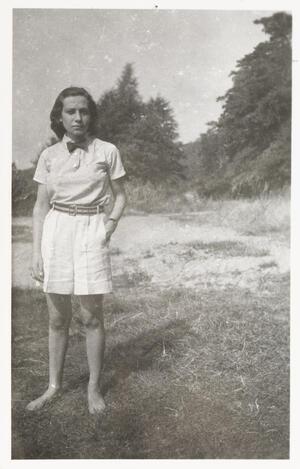Felice Schragenheim meets Nazi sympathiser Lilly Wust, sparking a famous love affair
Felice Schragenheim was a member of the Jewish underground in Berlin during World War II. On November 27, 1942, she was introduced to Lilly Wust, the wife of a Nazi soldier, and they began a torrid love affair memorialized in Erika Fischer’s semi-fictional novel Aimee und Jaguar (Aimee and Jaguar, the nicknames the women called each other). In 1999, the novel was made into a film of the same name.
Schragenheim was born in Berlin on March 9, 1922. She grew up in a middle-class family but was unable to finish school because of Hitler’s rise to power. Her parents died when she was young and her sister went to England. When World War II broke out, her only family member left was her grandmother, who was deported and killed in August 1942. When Schragenheim received deportation papers of her own, she went into hiding and assumed the identity Felice Schrader.
Schragenheim joined the Jewish underground in Berlin to help Jews hide or flee and worked under her fake identity at a Nazi newspaper, as she had always wanted to be a reporter. Afriend who worked in the home of Lilly Wust introduced them at a coffee shop on November 27, 1942.
Schragenheim was fascinated by the idea of attracting a Nazi sympathiser. She wooed Wust and soon they began a secret relationship, with Schragenheim keeping her true identity a secret. In February 1943, Schragenheim was forced to flee Berlin because of an increased crackdown on Jews called Operation Factory. She soon returned and made her relationship with Wust official, even holding an unofficial wedding ceremony. With Wust’s husband gone fighting the war, Schragenheim moved in with Wust under the pretext of being a caretaker for her children.
Tension between the couple built as Schragenheim came and went at odd hours to do work for the underground but was unable to tell Wust what she was doing. When things came to a head when Wust threatened to kick Schragenheim out, Schragenheim revealed her true identity, even sharing that she worked for the underground. Wust vowed to continue supporting Schragenheim and do everything possible to keep her safe.
In the summer of 1944, as conditions in Berlin became increasingly dangerous, the underground disbanded and members attempted to flee. Schragenheim, however, chose to stay with Wust. In August 1944, after returning from a picnic with Wust, she was arrested by the Gestapo. She was sent to Theresienstadt on September 5, 1944, before being transferred to Auschwitz on October 9. As the Allies closed in, the Nazis began to liquidate Auschwitz, sending prisoners on a death march to Gross-Rosen. Schragenheim died around that time, either on the death march or upon arrival in Gross-Rosen. Her exact death date is unknown.
Sources:
“Felice and Lilly—An Uneasy Berlin Love Story.” National WWII Museum New Orleans, March 8, 2021. https://www.nationalww2museum.org/war/articles/felice-and-lilly-uneasy-berlin-love-story.
Victims of the Persecution of Jews under the National Socialist Tyranny in Germany 1933 - 1945. “Schragenheim, Felice Felicitas Rachel.” Accessed July 19, 2022. https://www.bundesarchiv.de/gedenkbuch/en1155804.
Yad Vashem. “Felice Felicitas Rachel Schragenheim.” Accessed July 19, 2022. https://yvng.yadvashem.org/nameDetails.html?language=en&itemId=11629044&ind=0&winId=7611290214430985146.




What a beautiful and tragic tale of a courageous young woman. I wonder whatshe'd make of her story becoming so famous.